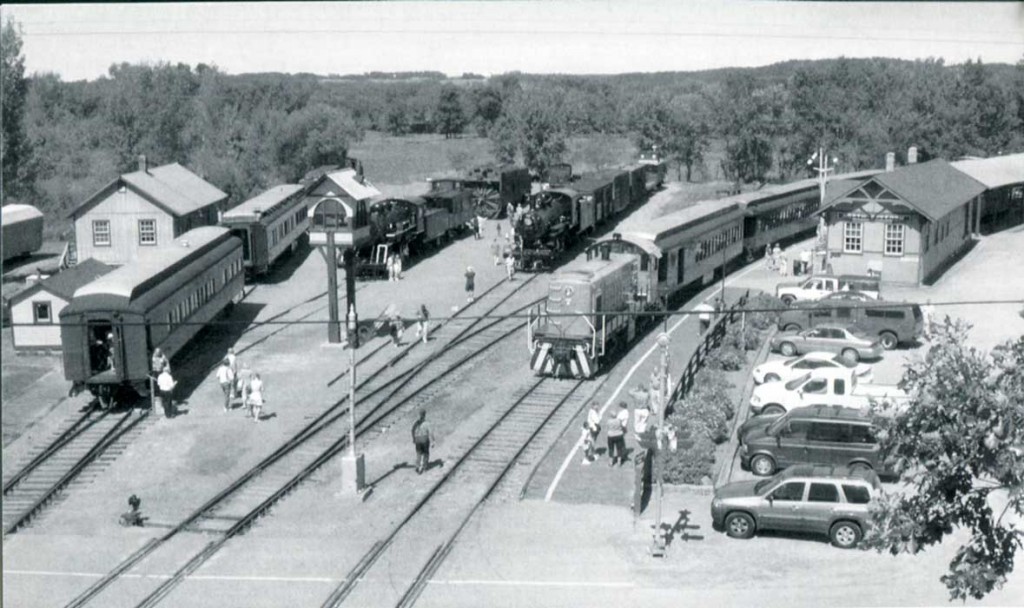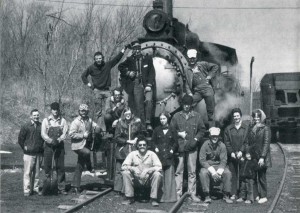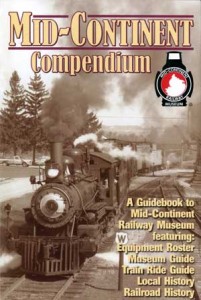A Guidebook to Mid-Continent Railway Museum
Published July 2005
A compendium is a summary of facts, principles or ideas which epitomize the most important aspects of a grander story or achievement. The Mid-Continent Compendium is all of that and more. It is our most ambitious publication to-date, requiring more than 100 pages to capture the photos, charts, graphs and text to adequately tell the Mid-Continent story of what has been achieved during our years in North Freedom.
A guidebook might be a better way of describing what this publication is as it takes you on an extensive tour that transcends time and the physical boundaries of our museum. Along the way you also get an overview of the history of the Village of North Freedom, the iron mining operations which brought the railroad into this area, and the larger presence of the railroads which permeated Sauk County.

The Mid-Continent Compendium contains over 100 pages of historical information, guides and informative photos and illustrations such as sample of railroad hand signals as seen on this sample page.
Museum guests enjoy our rural location. Most of them believe they have discovered an historic site, one which our organization inherited and merely refurbished in order to perpetuate the history of the railroads. In truth, when the Railway Historical Society of Milwaukee, as we were originally known, brought its small collection of equipment to North Freedom to establish the Mid-Continent Railway Museum, all that existed was one set of tracks on a narrow right-of-way and a lot of weeds.
Today we own more than 120 pieces of rolling stock, several buildings and a complex infrastructure serving to make Mid-Continent one of the most highly respected rail preservation museums in the country. The story behind every step in that development is what you will find filling the pages of this highly illustrated guidebook, which we call the Mid-Continent Compendium.

The view of the museum’s display yard from atop the water tower gives a good view of the scope of transformation that has taken place. Once only a single track overgrown with weeds, Mid-Continent is now home to more than 120 pieces of rolling stock.
The Compendium’s format resembles our members’ magazine, the Mid-Continent Railway Gazette. But its breadth of coverage exceeds anything we have ever endeavored in even the most ambitious of our special edition Gazettes. Since it was published prior to our decision to go to an all-color printing process, all of the images (except for the jacket photos) are in black and white. We might even say glorious back and white since none of the dynamic realism of an operating train museum is lost in the presentation.
One more thing that will become evident when you read or even quickly scan the pages of the Mid-Continent Compendium is that it is a tribute to the persistence and dedication of our members, who for more than five decades have labored to recreate the sights, sounds and activities of early 20th Century railroading. Mid-Continent’s story is their story and in these pages you will discover why our members take such great pride in being a part of it.

A group of Mid-Continent Railway Museum members gather for a photo in 1971. Their hard work put Mid-Continent on the map as a highly respected organization for rail preservation.
A final word of gratitude is needed to acknowledge the work of Paul Swanson, Mid-Continent member and volunteer Gazette editor, who compiled the content.
Copies of the Mid-Continent Compendium can be purchased in our gift shop, ticket office, and in our online gift shop.
Mid-Continent Compendium
For over a half-century Mid-Continent members have been been the driving force behind growing Mid-Continent Railway Museum as a nationally renowned organization for rail preservation. You too can join in preserving history by becoming a member.
RETURN to Mid-Continent Railway Gazette Main Page

